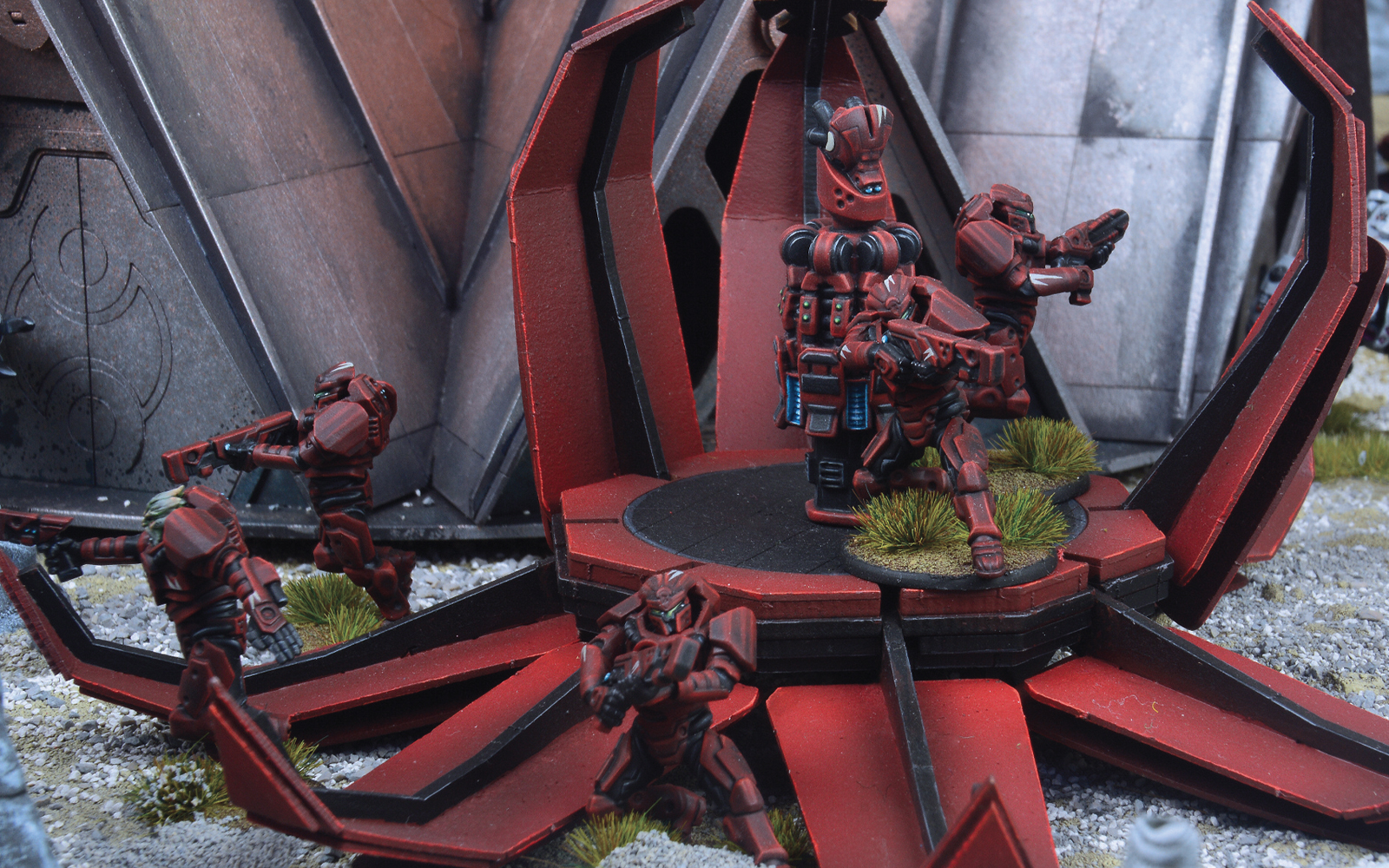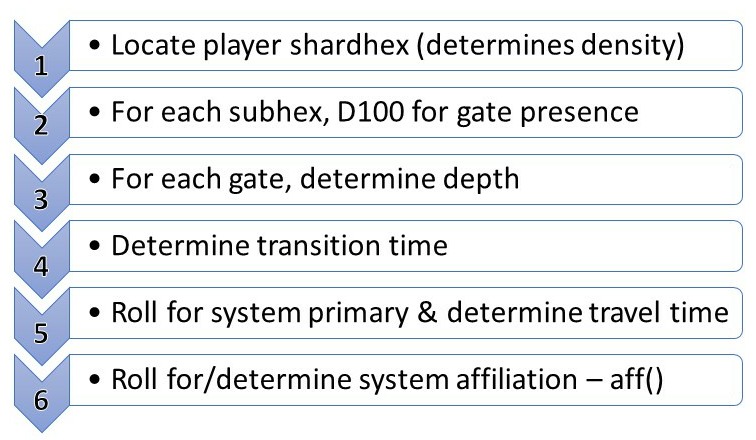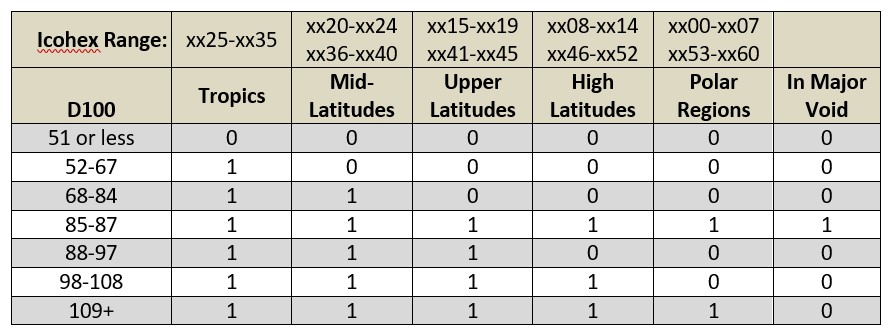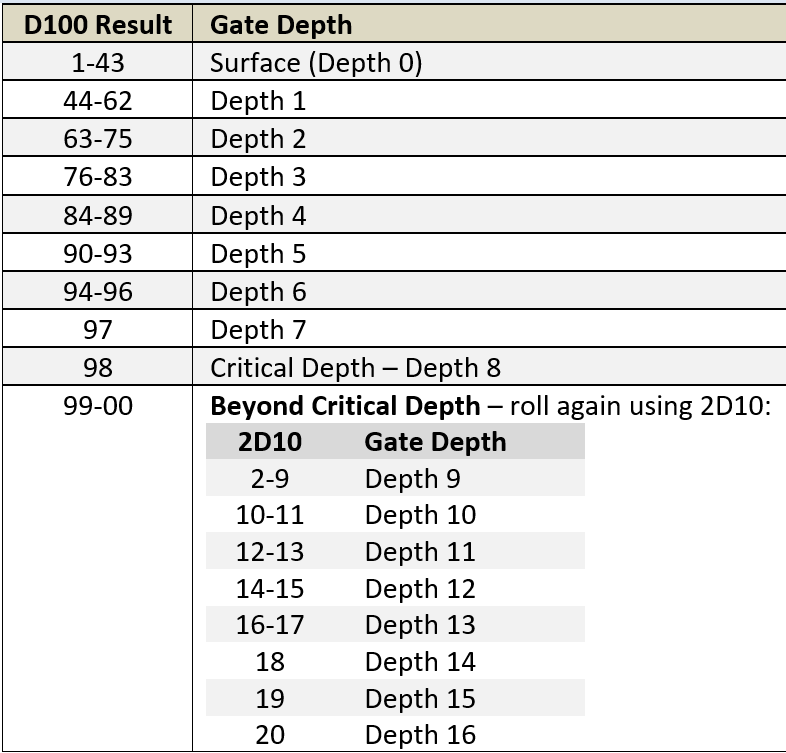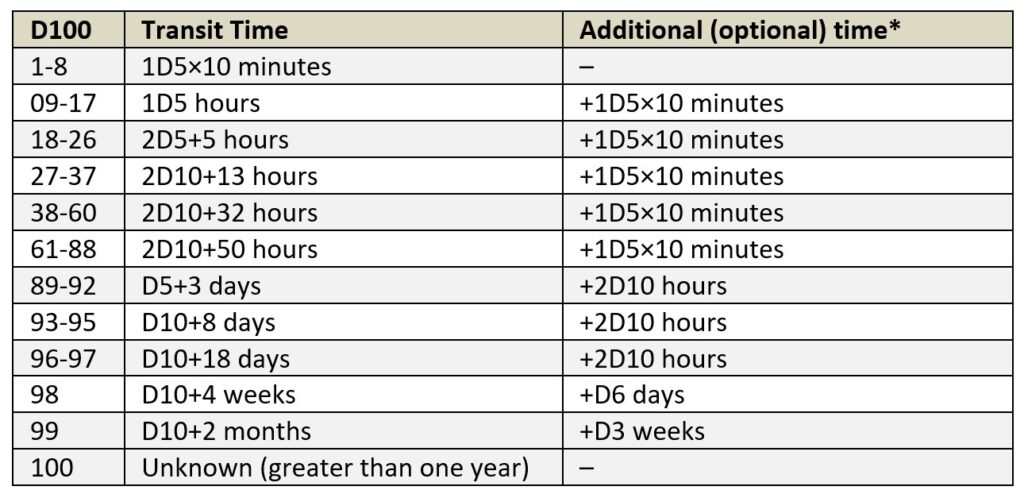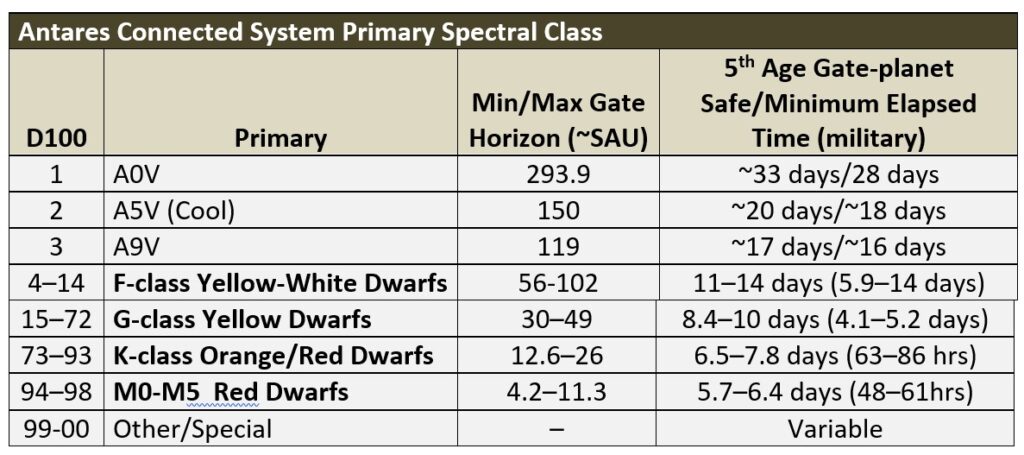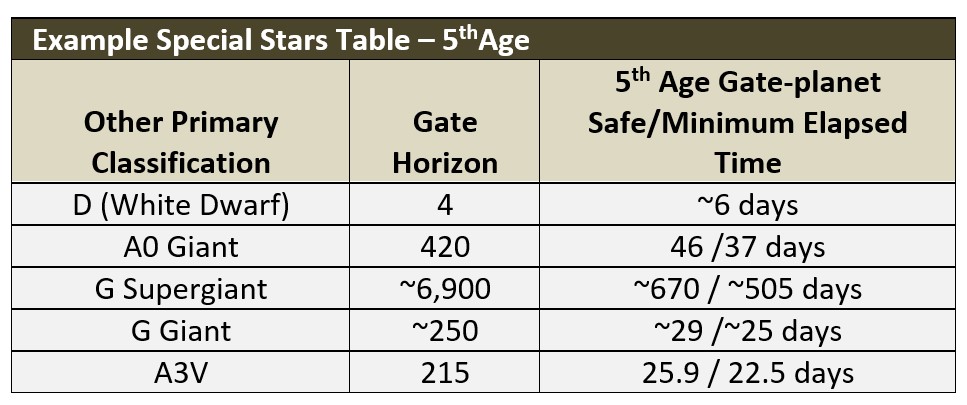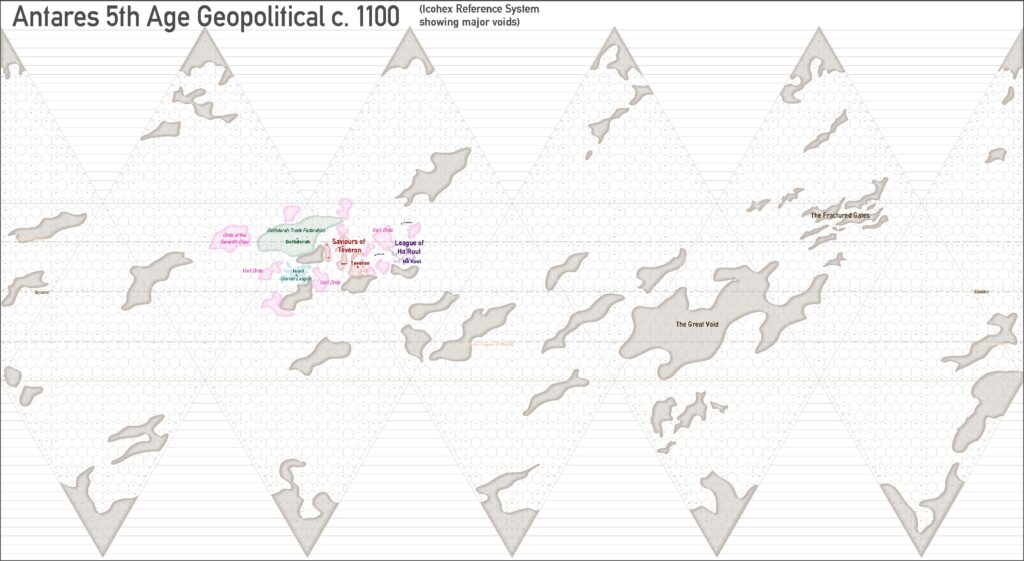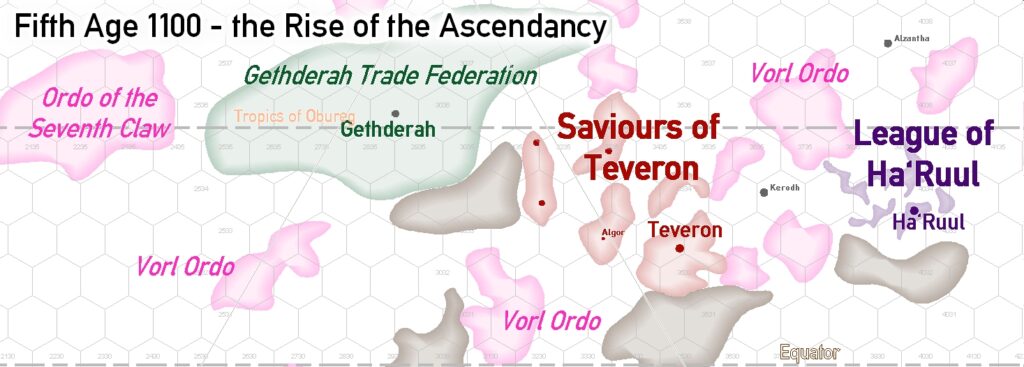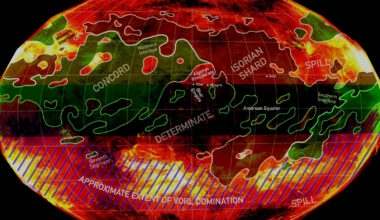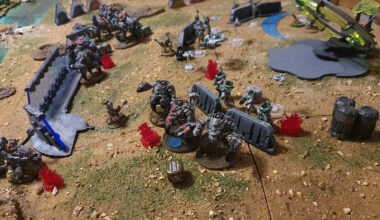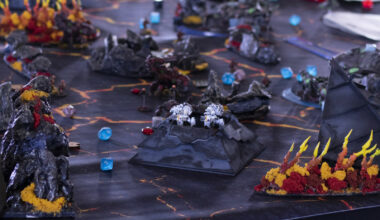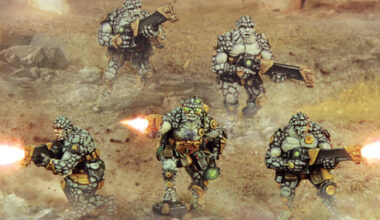The previous articles in this series painted a broad picture of the major events in the 5th Age of Antares and provided some insight into the numerous and disparate empires and petty-kingdoms that rose and fell during the period. It’s an age that is rife with potential sources of conflict and can make for a great player campaign using a wide variety of models.
To start with, we can map our own portions of the 5th Age surface of Antares just like we can in the 7th Age. The articles series for the 7th Age can be seen here on the community site – and the first two articles, in particular, are useful in understanding the process, but for the 5th Age we need to alter some of the tables. In general, gates were created more slowly than in the 7th Age, so the Gate Presence Table in the mapping articles would produce far too many systems, perhaps only matching those in the 7th Age towards the end of the Warring Ages. Another factor contributing to the isolation of many systems in the 5th Age was time, both in the longer gate transition times and the less effective starship drives resulting in longer gate-to-inner-planet transit times.
And, of course, the affiliation table doesn’t apply at all!
Process Overview
Mapping your own corner of 5th Age Antares follows the same process as described in the 7th Age articles. There are a few differences in the size of the major factions, and travel time and gate density is different. As a reminder, the process is as shown in the diagram below:
If wished, the position of the gate with respect to its primary can be determined by using the declination table and process originally given in https://warlord-community.warlordgames.com/mapping-your-own-antares-part-five/.
5th Age Gate Presence
We’ll focus our map generation efforts on the era just before the formation of the Ascendancy. To determine whether or not a gate is in a subhex (the basic mapping unit), roll D100 and check the following table. It was incredibly rare for a 5th Age subhex to have multiple gates – but there is nothing wrong with creating your own multi-gate subhexes!
Should you wish to create a map earlier or later into the 5th Age, subtract one from the dice for each hundred years in which your map is earlier than 5A1100, and add 1 to the dice roll for each 100 years after 5A1100 – up to around 2049, of course, when the gate collapse started (add 10 for dates around 2040 and subtract 20 after that for each year after 2049).
Antarean Gate Depth Table
This is reproduced from the original articles purely for ease of use as the depth distribution of gates is similar from one Antarean Age to the next.
5th Age Transition Time Table
As discussed, Transition Times during the 5th Age were longer than experienced in any other age of panhumanity on Antares. The reasons are unclear as, unlike other ages, there was no sudden collapse at the end of the 4th Age as there had been with the use of chronophasic devices or null-space weaponry in other ages. In contrast, the lengthy Fourth Age – the Xon Times – appeared to be brought to a close slowly when Obureg dimmed, so gate transit time is thought to relate to activity on or by Obureg.
* The extra time shown for these transit times are provided if more variation is required. These can also be used to generate more precise times by reducing the stated transit time by one time unit (an hour, a day, and so on) and adding the randomly generated lower time value. For example, a gate taking D10+4 weeks (a 98) could not only have the additional days stated (+d6) but could also have its hours and minutes calculated just by subtracting a day from the d6 ‘days’ roll and adding 2D10 hours and 1D5+10 minutes.
5th Age Gate Horizon-Planet Times
Whilst the prevalence of particular primaries in a connected system is roughly constant during all the ages of Antarean panhumanity, the less-efficient 5th Age drives extends the travel times. The in-system upper limit on velocity tends to only affect travel times in commercial vessels where the gate horizon is over 100 Standard Astronomical Units from the primary; military vessels, with their more risky and more secretive drives, have correspondingly quicker gate-planet travel times.
The hotter the star the further away the gate horizon sits and the longer the travel times. In general, the lower numeric rating the hotter a star is, so a G2 star (Sol) is hotter than a G5 star. Even within the general classification the stars can vary in their overall output. Here, Old Sol, a G2V class star with a gate horizon at 40SAU, would require an average gate-to-Old Earth travel time of nine days for merchant ships, five days for military vessels having around 16G acceleration and perhaps six days for cruise liners (7th Age ships take just two days or so to travel the same distance).
As an example of special stars we give the following, but players are encouraged to make up their own, including binary systems and such.
5th Age Affiliation
Unlike the cleanly-defined, massive and cohesive empires of the 6th and 7th Age, even the largest of the 5th Age Empires were widely dispersed. As a result, after you have created your own shardhex, you have a fairly free hand as to how and to whom the systems should be affiliated.
We suggest that major military installations, trade hubs and capitals are allocated in systems that have:
- At least two other gates within one sub-hex;
- G- or K- class stars as a primary;
- a gate above the critical depth; and
- gate transit times of 12 hours or less.
Given the longer in-system times in the 5th Age, transit times become a critical factor. No capital or military headquarters should be placed in systems with transit times of five days or more, though such systems could have a temporary, major military presence if they prove to be strategically vital! Even systems with transit times of two days or more mean that a system is likely to be less important than one with shorter transit times.
After selecting a capital, look at the surrounding gates. Those that are above critical depth or which have shorter transit times are likely to be important in some way (trade, population, military base, perhaps), so should be part of the empire; those with much longer transit times or beyond critical depth are likely to be independent and perhaps only support primitive civilisations.
Of course, one of the many raider fleets of the 5th Age may deliberately have its repair and refit base on an out-of-the-way system, but one from which they could launch attacks on poorly-defended (typically independent) targets within a reasonable radius, say 5 or 6 subhexes. System-shapers in earlier ages made a habit of building orbitals and repositioning hollowed asteroids near the gate horizon of A- and F-class star systems to serve as refuges or repair and refit docks. Though probably deserted, these could be repurposed as large, defensible headquarters for almost any force and the orbitals repaired and made to provide spin-gravity once more. This gives a six week, elapsed round trip on Antares, plus two sets of transit times (two local, two target) plus travel from the horizon-to-target-world and back, giving a 9–10-week raid – depending on transit times, of course.
A simple campaign can be built around the actions of such a raider fleet as ships are unlikely to hold too large a force. Having set up a raider force’s technology and structure – we’ll go over 5th Age armies in subsequent instalments – players can set the defences and peoples of each world it attacks. Both sies can accumulate victory points (many scenarios have balanced VPs – if there are none, perhaps allocate 5VP for a win and 3 VP for a draw). End the campaign after a set number of games or when one side or another has reached a set VP total (perhaps 20 with these VP): the raiders have to move on afterwards to different worlds, either because they have been defeated (hurray!) or because they have stripped the victims of useful resources (boo!).
One of the sad facets of the 5th Age is that worlds recaptured after a lengthy and continual Vorl presence of 100 years or more will be denuded of panhuman life. Local vegetation and creatures may remain, but the Vorl make a habit of seeding worlds with their own flora and fauna. After seeding a world, the Vorl also make crude adjustments to its climate to give their preferred livestock and food plants as great an ecological advantage as possible. Removing the Vorl’s flora and fauna from planets can take as long as it took to Vorl-form the planet in the first place. From a panhuman’s perspective, the only crumb of hope is that whilst Vorl obliterate all alien life on orbital installations and habitats, they much prefer planetary life and leave such installations alone and largely intact.
Antares 5th Age -Overall View
Many of the voids are in roughly the same areas across different Antarean eras, and even those in the 5th Age can be seen to have rough approximations to those in the 7th. However, the Warring Ages saw a few more, larger voids and areas of voids, the most notable being the Great Void and an area with a number of small rifts and greater voids called The Fracture Gates.
To show their location, we’ve placed the founding members of the Ascendency on the map, as well as the later position of the Isorian League of around 1350.
Antares 5th Age – The Ascendancy’s Core Factions
We have also marked the location of Teveron, Ha’Ruul and the Gethderah Trade Federation. Whilst all these three empires have much sparser system membership even at their core, their influence roughly covers the areas shown. The second map shows a little more detail around the trio of empires that first formed the Ascendency and the major Vorl Ordo that sat on their borders.
Next Instalment: Armies
In subsequent instalments we’ll discuss how the weaponry and troops of the 5th Age can be represented on the tabletop using the rules in Beyond the Gates of Antares and how you can build the military forces of the panhuman empire we have just mapped!
